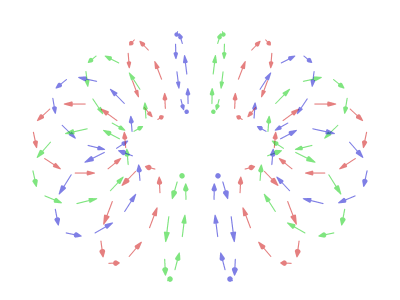 |
| "I'm having so much fun." |

Toroidal vortices
One of the main reasons why Air Bazookas are so fun is due to their funky doughnut shaped smoke clouds they produce. When you force a large volume of fluid through a small hole, you will get a toroidal vortex. This sounds very technical and esoteric, but a torus is just the mathematical description of a doughnut shape and a vortex is the spinning motion of a fluid - it's the doughnut rings of air that are fired out of the air bazookas.
How are they formed?
- The diaphragm of the air bazooka is pulled back and released, suddenly pushing air out of the bazooka. As the air approaches the hole, it has a uniform velocity.
- As it passes the hole, the air on the edge is slowed down by the drag from the surface of the hole, as well as coming into contact with the stationary air outside the bazooka. This forms a velocity gradient with the air in the centre of the hole/ inner layers having the greatest velocity and the air at the circumference/ outer layers with the lowest velocity.
- This velocity gradient causes the inner layers of air to "roll" around the outer layers, forming the vortex. Imagine an air molecule towards the outer layer - it is being pushed harder from the inner layers as they are travelling at a faster velocity than the air on the outer layers, giving the air angular momentum and causing it to spin.
Why are they so stable?
Another reason why Air Bazookas are endless fun is due to the fact that the air doughnuts hold their shape for a relatively long time before dissipating. Toroidal vortices are incredibly stable due to the fact that moving fluids exert less pressure on their surroundings than still fluids. Air molecules are constantly colliding with each other and their surroundings as they are a gas, meaing that there is air pressure. When you disturb air, there is still the same amount of kinetic energy, but more is in the direction of motion and less on the surface, meaning the pressure is lower for fluids with higher velocity. I'm not sure if that is a 100% correct derivation, but what we are discussing is Bernoulli's Principle: the fast air moves, the lower the air pressure. Since the velocity of air inside the vortex is greater than the velocity of air outside, there is also higher pressure surrounding the torus, which squeezes and maintains its shape. This net inwards pressure acts with the same principle as vacuum packaging to make the toroidal vortices very stable.
Why do they travel forward?
A further reason why Air Bazookas are so fun is that you can aim and fire them at other people - for us to understand why we can do this, we must appreciate why they travel forward in the first place. As the flow of air in the vortex "rubs" against the still air, friction causes the torus to move itself forward. This is exactly like how a bicycle wheel works: if you imagine a spinning bicycle wheel which is then dropped on the ground, the friction between the spinning wheel and the ground would cause it to move forward. Another analogy is like how a swimmer pulls himself/herself along through the water.
The energy required to move the ring forward and to keep the vortex rotating comes from the momentum of the rotating air inside the vortex. Air has momentum as it has mass. The spinning air inside the torus is where energy is stored - once all this energy is used up through work done to overcome the frictional forces, the doughtnut of air dissipates.
Why do they travel so far?
The last reason why air bazookas are so fun is that you can aim and fire air doughnuts at people several meters away. The reason why this is possible is the poloidal flow of air in the vortices - the flow of air around the "width" of the doughnut. Since the air is moving, the friction between the vortex and surrounding stationary air decreases, meaning that longer distances can be travelled with little loss of mass and kinetic energy with air doughnuts than if it was just a jet of fluid.
So in conclusion, it's all a matter of fluid dynamics.
I feel like I should start referencing where I get my information from. Here are my main sources:

